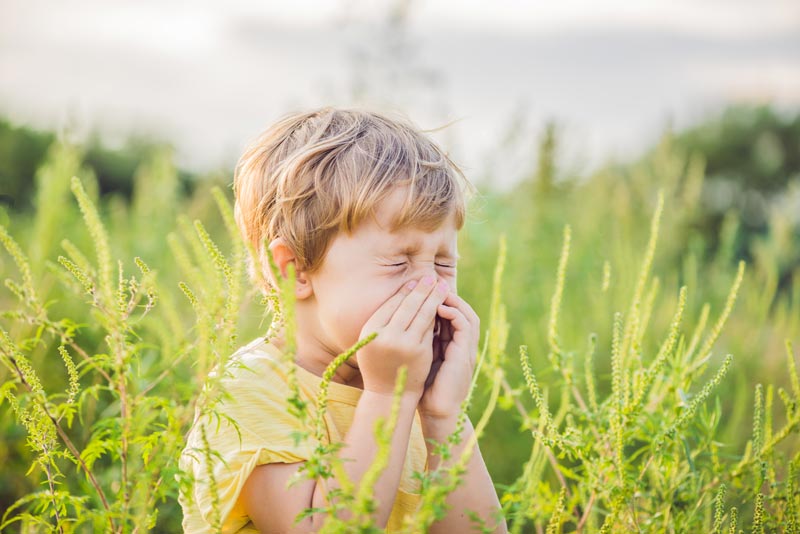How To Reduce The Annoying Symptoms of Fall Allergies
Autumn brings cool football evenings and splashes of colorful leaves in many places, but it also shepherds unwelcome and invisible irritants into the autumn air. We’re talking about fall allergy season. The more you know about the causes of fall allergies and the symptoms of each, the better equipped you’ll be to win your battle against these unseen invaders. Find out how technology and best home practices play a role in easing allergy distress.
Common Allergies in the Fall
Visit your local supermarket, and you’ll probably find dozens of allergy medications on the shelves. Most of these are designed to fight the various histamines your body produces. Histamines are chemicals released by your body when something you are allergic to touches you, is inhaled, or swallowed. The histamine compound causes allergy symptoms, especially around the nose, throat, and sinuses.
3 Main Fall Allergens:
- Ragweed is the fall pollen source for hay fever, and more than 50 million Americans have ragweed allergies.
- Mold is a problem year-round, but it can worsen in the cool season as evaporation decreases and moisture collects.
- Dust mites are microorganisms that live within dust inside warm buildings. The symptoms of dust mite allergies are similar to those of ragweed.
Symptoms of Fall Allergies:
Unfortunately, the symptoms of ragweed, mold, and dust mites are very similar; they may include one or more of these:
- Sneezing
- A feverish feeling
- Itchy or watery eyes
- Itchy skin or rashes
- Headaches
- Congestion
- Runny nose
Which Fall Allergy Is Bothering You?
Ragweed, mold, and dust mites may cause similar symptoms, and this can make it a challenge to identify what’s causing the problem. Here are some ways to narrow down the list of what’s bothering you.
Ragweed
Monitor the pollen daily and see if there’s any connection between your symptoms and changes in the report. Spend more time outside one day and less the next; see if there’s any change in your condition. Ragweed season runs from August to October, so a set of allergy symptoms in December is likely caused by something other than ragweed. Colds can mimic ragweed allergies, but a cold rarely lasts more than a week — so a longer “cold” might be an allergic reaction.
Mold
Mold allergies can be especially difficult to diagnose. They tend to get worse in the wet season or if there are areas of moist insulation, drywall, or organic material inside your home. Keep a temperature and humidity sensor in your home to remove some of the moisture mystery.
Dust Mites
Symptoms of dust mites are similar to ragweed, but three important differences may help in discovering whether dust mites are the culprit: 1) Dust mites can cause a reaction year-round; ragweed is an issue in the fall only. 2) Dust mite allergies will get worse if you’ve recently stirred up a lot of grime in your home or perhaps had dirt come in from a dust storm or other external source. 3) Dust mite allergies can last for years unless you get rid of the dust.

How To Reduce Allergies in the Fall
Since you spend more than half of your indoor time in your own home, allergies during the fall and year- round will be less intense if you keep indoor air pollution to a minimum. Here are a few steps — especially crucial if you have asthma or chronic obstructive pulmonary disorder — to help make that happen.
A good start to a healthy house or apartment is to get a quality home air monitor that will help you track how clean the air is in your home. Remember, pollen, dust, and mold are allergy culprits. Speaking of mold, you’ll want to keep the indoor relative humidity within a healthy range to reduce mold growth — an inexpensive indoor temperature and moisture monitor takes out the guesswork. Here are some additional tips:
- Stay indoors on dry, windy days.
- Wear a mask outdoors if you know the pollen count is high.
- Remove clothes you’ve worn outdoors and take a brief shower to rinse pollen off of your skin.
- Mop all floors with a damp mop or rag; don’t sweep, as this will put more dust/pollen in the air.
- Keep the relative humidity between 30% and 50%.
- Inspect your roof, plumbing, and ductwork for leaks. These are the primary breeding grounds for mold.
- Make sure you change all of your heating, ventilating, and air conditioning filters monthly. Consider spending a little more on the higher-efficiency versions that work better at trapping air particles.
- Get a vacuum cleaner with a HEPA filter which is more efficient at capturing dust and pollen than a regular vacuum cleaner.
- Consider buying a home air-purification unit that can remove 99% of dust and mold from the air.
- If none of these suggestions help, seek help from a medical professional — allergy tests, acupuncture, or medicines may provide the relief you need.
Getting the Upper Hand on Fall Allergies
Let’s face it, fall allergies are no fun, but following a step-by-step strategy to narrow down the potential suspects can bring you some relief. It’s like one of those crime shows on TV. Whodunit? Figure that out, and you’re well on the way to enjoy autumn with fewer sniffles, sneezes, and scratches!
Steve LaNore is a certified broadcast meteorologist with more than 30 years of forecasting and technical experience. He has provided meteorological consulting for everything from insurance adjusters to court cases and is a nine-time award-winning author and broadcaster. LaNore has authored two books, available on Amazon. He resides in north Texas near beautiful Lake Texoma.





